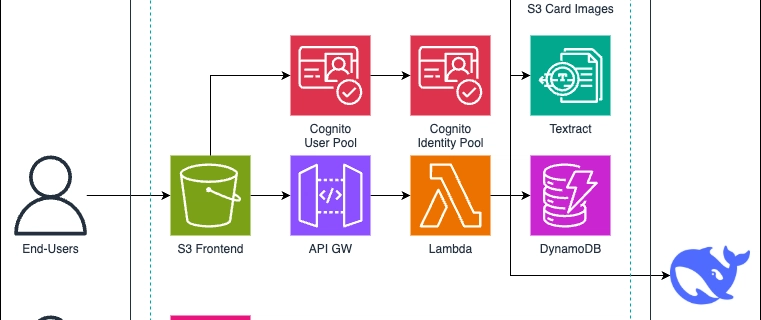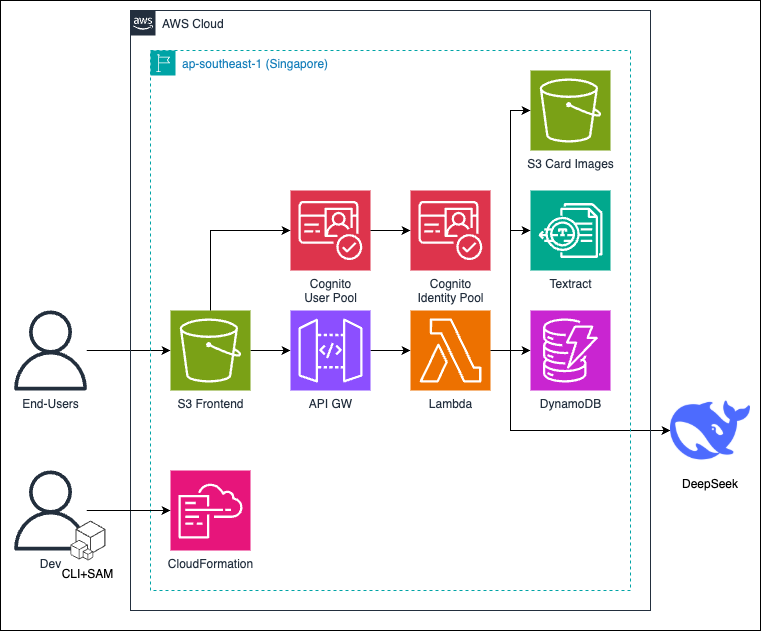Building a Modern Business Card Scanner with AI: A Deep Dive into AWS and DeepSeek Integration
Hey there, fellow developers! 👋 Today, I'm excited to share my journey of building a modern business card scanner application that leverages AI to transform physical business cards into organized digital contacts. This project combines AWS services with the DeepSeek API to create a powerful networking tool.
🎯 The Problem
In today's digital age, we still exchange physical business cards, but managing them efficiently is a challenge:
- Cards get lost or damaged
- Manual data entry is time-consuming and error-prone
- It's hard to analyze your professional network effectively
- Finding specific contacts or seeing connections between companies is difficult
There are existing digital business card scanning solution in the market, but they are often:
- expensive
- not user friendly
- only supports internal address book, no integration with device contacts
- data stored in the providers' database, you don't own the data
💡 The Solution
I built a web application that solves these problems by:
- Using AI to extract information from business card images
- Organizing contacts with rich metadata
- Allows importing the contacts to your phone contacts in batch!
- self-deployable solution, meaning you own and control your data!
- Providing network analysis and visualization
- Offering an AI-powered chat interface for querying your contact database
🏗️ Technical Architecture
The application is built on a modern serverless stack:
Key Components:
-
Frontend:
- Single-page application hosted on S3
- Interactive network visualization using D3.js
- Real-time chat interface
- Responsive design with Tailwind CSS
-
Backend:
- AWS Lambda for serverless compute
- Amazon Textract for OCR
- DeepSeek API for intelligent data extraction
- DynamoDB for contact storage
- S3 for image storage
-
Authentication:
- AWS Cognito for user management
- Secure API access with IAM roles
🔍 Key Features
1. Intelligent Card Scanning
def parse_with_deepseek(raw_text):
prompt = (
"Extract the following information from the provided business card text: "
"name, company, department, title, email, phone, address, website. "
"Additionally, categorize the company's industry..."
)
# DeepSeek API integration for smart data extraction
2. Network Analysis
function updateNetworkVisualization() {
// D3.js force-directed graph
const simulation = d3.forceSimulation(nodes)
.force("link", d3.forceLink(links).id(d => d.id))
.force("charge", d3.forceManyBody())
.force("center", d3.forceCenter(width / 2, height / 2));
3. AI-Powered Chat Interface
def handle_chat_message(event, cors_headers):
"""Handle chat messages using DeepSeek."""
# Process natural language queries about your contacts
# Generate insights and recommendations
🚀 Getting Started
Want to try it yourself? Here's how:
- Clone the repository:
git clone <repository-url>
cd business-card-scanner
- Install dependencies:
cd application
pip install -r requirements.txt
- Configure AWS and DeepSeek:
Environment:
Variables:
DEEPSEEK_API_KEY: 'YOUR_API_KEY'
- Deploy:
./deploy.sh
🎨 User Experience
The application provides a seamless experience:
- Upload business card images (single or batch)
- AI automatically extracts and categorizes information
- View your contacts in a modern, filterable interface
- Explore network connections through interactive visualizations
- Chat with AI to analyze your professional network
- Easily export contacts as vcard files for your phone contacts
💰 Cost Estimation
AWS: Total 12 months cost = 15.00 USD AWS Pricing Calculator
DeepSeek API: minimum spend = 10RMB = 1.38 USD (1USD = 7.24 RMB)
Total Annual Cost = AWS+DeepSeek key = 15+1.38=16.38= around 16.5 USD
main assumptions:
Number of API Requests 1000 API requests each day x 20 working days = 20000 API requests per month
Number of scan card requests: 1 card each day x 30 days = 30 requests
🔮 Future Enhancements
I'm planning to add:
- Maybe with https so that the can directly scan with device mobile
- Better UI/UX and improve latency with AI chatbot.
- The current serverless architecture is a "Lambdalith", which is great for quick development for PoC but does not scale well with more features coming in. So may need decouple this part in the future.
🤔 Key Learnings
Building this project taught me several valuable lessons:
- Serverless architectures need thoughtful timeout configurations
- User experience is crucial for AI-powered application
🎁 Open Source
This project is open source! Feel free to:
- Star the repository
- Submit issues or feature requests
- Contribute improvements
- Fork and adapt for your needs
🔗 Resources
👋 Connect
I'd love to hear your thoughts and suggestions! Connect with me:
- GitHub: [https://github.com/john-ng-hk]
- LinkedIn: [https://www.linkedin.com/in/john-nch-hk/]
Let me know in the comments if you'd like to see more detailed posts about specific aspects of this project!




Top comments (0)